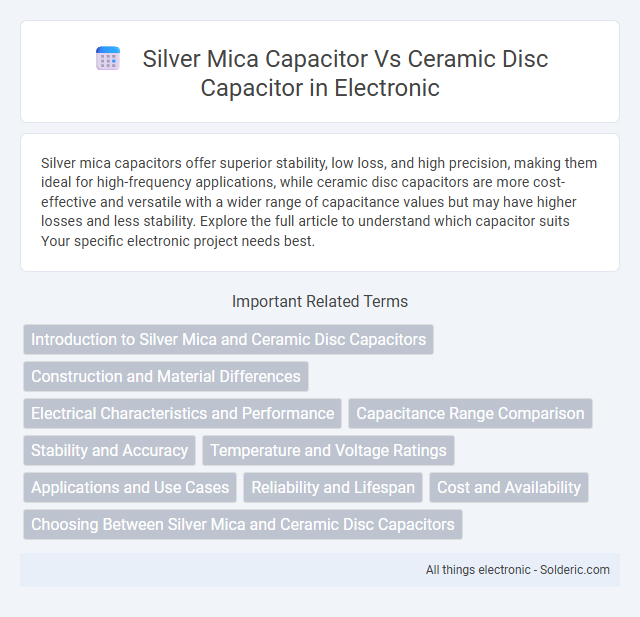Silver mica capacitors offer superior stability, low loss, and high precision, making them ideal for high-frequency applications, while ceramic disc capacitors are more cost-effective and versatile with a wider range of capacitance values but may have higher losses and less stability. Explore the full article to understand which capacitor suits Your specific electronic project needs best.
Comparison Table
| Feature | Silver Mica Capacitor | Ceramic Disc Capacitor |
|---|---|---|
| Dielectric Material | Silver Mica | Ceramic |
| Capacitance Range | 1 pF to 0.1 uF | 1 pF to 1 uF |
| Tolerance | +-1% to +-5% | +-5% to +-20% |
| Temperature Stability | Excellent (+-50 ppm/degC) | Good to Moderate (varies by class) |
| Frequency Response | High frequency, low loss | Moderate frequency, higher loss |
| Voltage Rating | Up to 500V or more | Up to 1kV (varies) |
| Application | RF circuits, precision tuning | General purpose, decoupling |
| Cost | Higher | Lower |
| Size | Smaller for given capacitance | Larger for given capacitance |
Introduction to Silver Mica and Ceramic Disc Capacitors
Silver mica capacitors offer exceptional stability, low loss, and precise capacitance, making them ideal for high-frequency and RF applications. Ceramic disc capacitors provide a cost-effective solution with higher capacitance values and strong insulation but exhibit less stability and greater temperature sensitivity. Your choice depends on the need for accuracy and stability versus budget and capacitance requirements.
Construction and Material Differences
Silver mica capacitors use a dielectric made from mica sheets coated with a thin layer of silver, renowned for its stability, low loss, and high precision, whereas ceramic disc capacitors employ ceramic materials like titanium dioxide or barium titanate as the dielectric, offering higher capacitance values but with more variability in performance. The construction of silver mica capacitors involves stacking multiple mica layers between silver electrodes, encapsulated in epoxy or metal cases, ensuring excellent temperature stability and low inductance. Ceramic disc capacitors feature a single or multilayer ceramic disc coated with metal electrodes and encased in epoxy resin, providing compact size and cost-effectiveness but with less precision compared to silver mica types.
Electrical Characteristics and Performance
Silver mica capacitors exhibit high stability, low loss, and excellent temperature coefficients, making them ideal for precision timing and RF circuits. Ceramic disc capacitors offer higher capacitance values and better voltage ratings but may have higher dielectric absorption and less stability under temperature variations. Your choice depends on whether you prioritize precision and low loss (silver mica) or cost-effectiveness and larger capacitance (ceramic disc).
Capacitance Range Comparison
Silver mica capacitors typically offer capacitance values ranging from 1 pF to several hundred picofarads, making them ideal for precision applications requiring stable and low-loss performance. Ceramic disc capacitors provide a broader capacitance range, from a few picofarads up to several microfarads, suitable for general-purpose uses with varying dielectric types affecting stability and tolerance. You should consider the required capacitance value and stability when choosing between silver mica and ceramic disc capacitors for your electronic design.
Stability and Accuracy
Silver mica capacitors exhibit superior stability and accuracy compared to ceramic disc capacitors due to their low dielectric loss and minimal temperature coefficient, making them ideal for precision timing and RF applications. Ceramic disc capacitors, especially those with Class 2 or Class 3 dielectrics, tend to have higher temperature and voltage coefficients, resulting in greater capacitance variation under different operating conditions. Engineers prioritize silver mica capacitors in circuits demanding consistent capacitance and low tolerance drift for reliable performance.
Temperature and Voltage Ratings
Silver mica capacitors offer superior temperature stability, with operating ranges typically from -55degC to +125degC, making them ideal for precision applications requiring minimal capacitance variation. They also handle higher voltage ratings, often up to several kilovolts, ensuring reliability under high-stress conditions. Ceramic disc capacitors generally have wider temperature ranges but lower voltage limits, making them more suitable for general-purpose circuits rather than high-voltage or temperature-sensitive applications.
Applications and Use Cases
Silver mica capacitors excel in high-frequency, high-precision applications like radio transmitters, RF circuits, and oscillators due to their low loss and stability. Ceramic disc capacitors are widely used in general-purpose applications such as decoupling, filtering, and timing circuits where cost-effectiveness and moderate performance are sufficient. Your choice depends on the need for high accuracy and stability versus budget and size constraints.
Reliability and Lifespan
Silver mica capacitors exhibit superior reliability and longer lifespan compared to ceramic disc capacitors due to their stable dielectric properties and low loss characteristics. Silver mica capacitors maintain consistent capacitance over a wide temperature range and withstand high voltage stress without significant degradation. Ceramic disc capacitors, while cost-effective and compact, tend to have shorter lifespans and can experience capacitance drift and dielectric breakdown under prolonged thermal and electrical stress.
Cost and Availability
Silver mica capacitors generally cost more than ceramic disc capacitors due to their superior stability and low tolerance levels, making them less common in everyday applications. Ceramic disc capacitors are widely available and more affordable, often chosen for cost-sensitive projects or mass production. Your choice between the two should consider budget constraints and the specific performance requirements of your circuit.
Choosing Between Silver Mica and Ceramic Disc Capacitors
Silver mica capacitors offer superior precision, stability, and low inductance, making them ideal for high-frequency applications and RF circuits, while ceramic disc capacitors provide cost-effective solutions with a wide range of capacitance values, suitable for general-purpose filtering and bypass. The choice depends on required tolerance, temperature stability, and frequency response, where silver mica excels in critical timing and tuning circuits but ceramic discs are preferred for bulk bypass and decoupling. For designs demanding minimal loss and high reliability, silver mica capacitors dominate; ceramic discs are favored in applications prioritizing size and affordability.
silver mica capacitor vs ceramic disc capacitor Infographic

 solderic.com
solderic.com